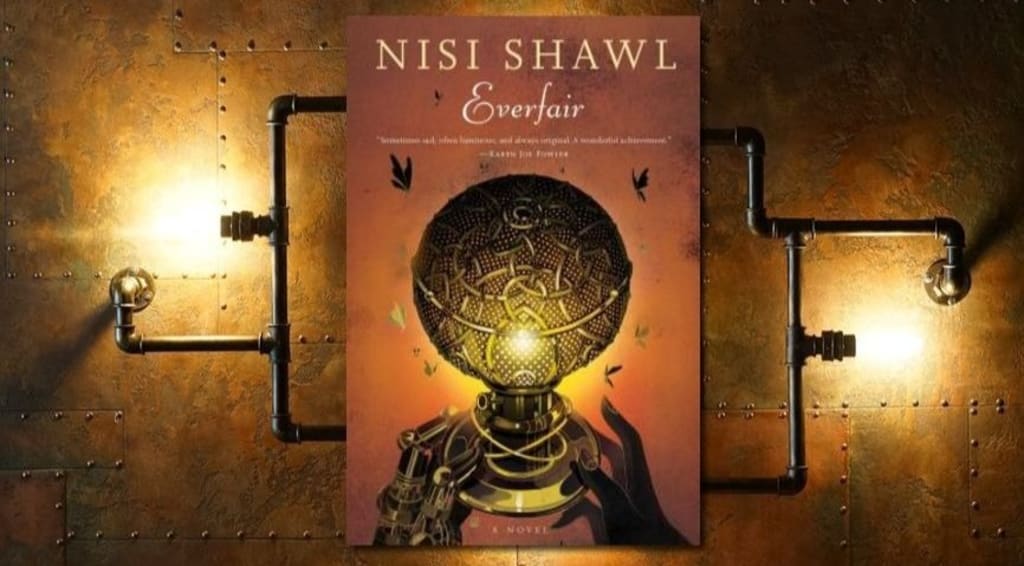Book Review: 'Everfair' by Nisi Shawl
Alt-history steampunk set in the Congo.

On the surface, Everfair by Nisi Shawl is an alternative history novel about an imagined country named Everfair that was co-founded by black American Christian missionaries fleeing the oppression of post-Reconstruction era United States, indigenous Africans of several different tribes, and the British Fabian Society. Many black Americans did settle in Africa during the 19th century (see the country of Liberia for one example). African countries now are comprised of several different tribes. And the Fabian Society exists in our world even today.
In Everfair, the goal of the Fabian Society, a socialist organization which prefers to effect change through gradual democratic reform rather than out-and-out revolution, is to establish through land purchase and colonization, a country within the Congo Free State that was ruled by the astonishingly cruel and twisted Leopold II, the constitutional monarch of Belgium (To be clear, it was ruled directly by Leopold himself, not the government of Belgium).
When Westerners think of atrocities, Hitler and the Holocaust typically top the list. Leopold and the Congo should be right up there with it. It’s true that many at the time were disgusted by him and what he did. International criticism caused Belgium to force Leopold to eventually cede them the Congo, and his funeral procession after he died was booed. But that does not change the death toll or that this was allowed to go on for so long. Between one and fifteen million people died. No one knows for sure because, frankly, few cared enough to keep track.
Within the novel, the Fabian Society has decided that they are going to build a colony in (secret) hopes that a white European will be killed by Leopold’s men—an unwitting martyr—thereby eliciting international white outrage and sympathy with the Africans’ plight. This does happen, but not in the way planned, though it does launch a tight bond and cooperation with the local king Mwende and his favorite wife Queen Josina, whose interests have coincided with those of the colonists.
The steam element comes through Tink (Ho Lin-Huang), a Chinese Everfairer from Macao, who had been brought in to work on the railroads and other technologies built to transport Leopold’s rubber. With the help of other engineers, Tink develops “aircanoes,” what we might call airships in other more Eurocentric steampunk novels. Tink also invents ingenious mechanical hands, for those who have lost their natural hands in Leopold’s tortures, and shonguns, a shooting weapon based on the African multi-bladed shongo (shongo + gun, one assumes). The aircanoes (along with the bombs they drop) and shonguns both give Everfair an edge in their battle against Leopold.
There are several characters at play in this book that spans thirty years in 384 pages of paperback, and I won’t get into all of them here. Instead, I will highlight why this book has special meaning for me.
One of the first things we learn about the members of the Fabian Society is that they are proponents of free love. Main character Daisy is married to Laurie (Laurence). Laurie also keeps two live-in lovers Ellen and Lisette. Daisy also has a relationship with Everfair co-founder Jackie (John). However, one of the enduring points of conflict throughout Everfair is the relationship between Daisy and Lisette. Daisy, if not also Lisette, is clearly what we today would call a bisexual woman.
The nontraditional relationships don’t stop there. Daisy’s son George, who is white and English, marries a black American woman, Martha, who is roughly twenty years his senior. Fwendi, an African-born intelligence agent, falls in love with white playwright Matty (Matthew). Tink falls in love with Daisy’s daughter Lily. King Mwende has multiple wives, as does Thomas Wilson, an American-born missionary and military officer who reluctantly converts to one of the native African religions, becoming a kind of warrior-priest. Multiple lesbian relationships are also shown.
Through Wilson and Fwendi both, we see glimpses of African religion and “mystical” tradition. The secret of the aircanoes flight lies in sacred earth unique to the region that is protected by priests. Wilson astral projects in his dreams and wields great power. Fwendi is such an effective spy because she… Well, I’d rather not spoil it, but suffice to say it involves cats, and I was very pleased.
This blending of science and magic is classically steampunk, yet used in a way that we don’t typically see in a genre that very often centers on white Europe. Shawl is able to brilliantly weave together all of these multicultural and inter-generational threads into a beautiful, well-crafted tapestry.
The characters are so rich that I wish I could have spent more time with each and every one of them. I would be interested in seeing this big and complicated world brought to the screen, perhaps in the form of an epic, multi-season long, big budget television show? (I definitely wouldn't say no to multicultural bisexual representation on TV!) Right now you can find all of this and more in Shawl's novel.
About the Creator
Crysta Coburn
Crysta K. Coburn has been writing award-winning stories her whole life. She is a journalist, fiction writer, blogger, poet, editor, podcast co-host, and one-time rock lyrics writer.






Comments
There are no comments for this story
Be the first to respond and start the conversation.